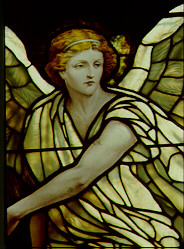The following steps will guide you through the process
(from the inception of the ideas to the full installation of the Stained Glass Window)
so you may fully appreciate this time needed to complete this 12 step process.
1. Accurate Measurements & Setting information.
It is key to get the correct measurements of the window opening as well an idea of the other existing stained glass windows and the interior decor of building or church that the window will be installed in.
2. Discuss Window Ideas with Client
We may show the customers some stock designs so that there is a better understanding of what they can have for their window openings. The subject of the window is usually determined after the first meeting with RML.
3. The In house Artist will Create a Design
We take many things into consideration so that the design will fit with the style of the existing windows of the church as well as the donor’s & committees needs. All designs are created with a one inch to one foot scale so that it is easy to visualize. In the case that the church does not have any stained glass windows, the designer will provide a preliminary plan giving the church committee some suggestions for future stained glass windows down the road. For example the theme in a church may be showing the life of Jesus Christ from birth, then preaching , then dying on the cross and then resurrection.
3. Designs are Approved Prior to Production
The design must be approved by all parties concerned prior to production commencing. Prices are discussed as well as an expected date of delivery or installation. RML requests a deposit of 50% of the total cost of the window.
4. The Window Design is Initiated
The design will be enlarged to represent a full scale of the hand designed stained glass window.
5. The Glass Cutter Chooses Pattern and Hand Blown Glass
Our glass cutter will choose the best colours and glass pieces to create the window from the full scale drawing. They will cut the design into patterned paper. Each piece of the patterned paper will be skilfully created to the design (making allowance for the size of the lead in between each glass). After the paper patterns are completed, the glass cutter will look at the colour of the design and pick out the colour of each piece with the paper pattern and start cutting the glass piece by piece.
6. The Painters Picks the Glass
The painter will have to select the best glass pieces and paint a trace line (outline) on the glass. When all the preliminary trace lines are done, the painter then loads the glass and puts the pieces onto trays filled with camel white(limestone). The limestone trays prevent the glass from warping during the firing process. The glass has to be fired from bottom to the top, meaning it will have to be fired from cold so that the heat builds up gradually to prevent the cracking of the glass. At the end of the firing process, the glass has to be cooled gradually so that the glass will not shock or crack.
7. The Painter Puts on the Shading and Background Highlights
After the glass pieces are all fired with traced lines, the glass pieces will be waxed up on an easel and then the painter will put on the shading and background highlight of the whole window except the flesh parts of the body such as the face, hands and feet. After all the shading of the background of the windows are done, each piece will be knocked down carefully so that no wax attaches on the glass. Each piece of glass will then be put back on the limestone trays and another firing process of the glass will begin. The flesh parts of the windows (such as the hands, face and feet) will have to be handled separately. These flesh parts will be matted and then needled to get the softness required to look life-like. Again, the glass will be re-fired. The pieces will be taken out to put on hair colour enamel, flesh enamel or some ruby colour for the lips After all enamels are put on, the glass will be fired again for the last time. After all the firing are done, all trays of glass will be put on the glazier's bench.
8. The Glazier Puts the Window Pieces Together
The glazier will have to put all the glass on the cut line. Then he will have to start glazing the window together by joining them with lead. After all lead work is completed, he will then have to solder the lead joints together.
9. The Window is Cemented
After the window are leaded and soldered, then the window have to be cemented to make them waterproof.
10. The Window is Dried
Each window has to be dried for a couple of days and then put on the easel to be viewed by the painter to complete the final touches.
11. The Window is Shipped in a Custom Crate
For windows that are to be installed out of town, the company builds custom crates and then ships to the destination or for local installations the company drives the window in the truck.
12. The Window is Installed
The window is professionally installed by Robert McCausland Ltd or a reputable company with experience.
